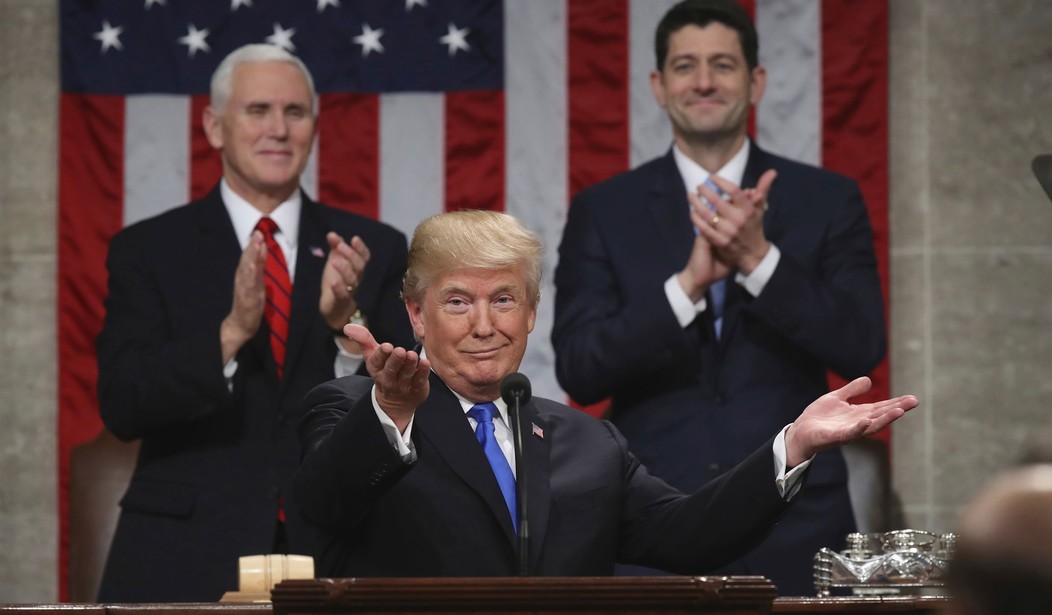With the Kavanaugh confirmation drama emerging as an all-consuming political story over the last two weeks, it may be somewhat inevitable that many voters don't hear much about significant economic developments. With Republicans holding a consistent lead over Democrats on the issues of job creation and the economy -- and with President Trump and his party bearing primary responsibility for US economic conditions in most voters' minds at this point -- Democrats and their media allies have every incentive to shine the spotlight elsewhere. But news like this must not be ignored:
Meanwhile, citing tax reform, GE announces $200 million investment in US manufacturing, creating hundreds of new jobs: https://t.co/Lo3pMDcglR #Armageddon #Crumbs
— Guy Benson (@guypbenson) October 1, 2018
While the U.S. manufacturing industry expands at a robust clip, GE Appliances, a Haier company, continues to place big bets on—and make major investments in—manufacturing operations in the United States. So far in 2018, GE Appliances has made a series of investments in the U.S. totaling $275 million. The company invested $150 million to open four new distribution centers across the United States, which will support 220 new jobs...On Monday, GE Appliances unveiled their biggest move yet, announcing a...new $200 million investment in its Kentucky dishwasher and laundry manufacturing operations that will support up to 400 new manufacturing jobs and help the company meet increasing consumer demand. “The changes in rates and favorable tax treatment of investments in machinery and equipment play a big role in our expansion plans,” Kevin Nolan, president and chief executive officer for GE Appliances, said Monday morning in the announcement of the investment.
Please notice that tax reform isn't a factor here; it's the factor. In a recent CBS News poll, fully 75 percent of voters describe both the national and their community economies as 'very' or 'somewhat' good. We also learned last week that the finalized second quarter US GDP growth rate was confirmed at a very robust 4.2 percent, with more positive news expected:
Recommended
The U.S. economy grew as expected in the second quarter, according to a reading Thursday that confirmed that gross domestic product rose at its quickest rate in nearly four years. GDP, the broadest measure of how the economy is progressing, increased 4.2 percent, the Commerce Department's Bureau of Economic Analysis reported, the same as expected from economists surveyed by Thomson Reuters. It was the fastest pace since the third quarter of 2014. This was the final reading for the quarter and now sets the stage for Q3 and what is expected to be a year that will show growth better than 3 percent, which the Trump administration has set as its goal.
That CNBC article cites economists who believe the US economy's third quarter growth will remain strong, but will be slowed down by ongoing trade disputes, which have hurt a number of American industries. But there's positive news on that front, too, as an overhauled NAFTA agreement has apparently been struck. The US and Mexico came to an accord several weeks ago, and now the Canadians have re-entered the fold. Whether the new free trade agreement is substantively superior to the original terms of NAFTA is very much in dispute, but resolving a prolonged and damaging spat with our North American neighbors is certainly a welcome overall development. Last week, the Trump administration inked a new, revised trade agreement with our South Korean allies. Our talks with the EU remain underway, with those trade war escalations paused. If the Trump administration can attain acceptable deals with our friends, it may allow them to apply more pressure on China, our key trading partner against whom we've launched are more legitimate claims of bad-faith and unfair practices. In other words, if our trade trajectory is pointed in a more promising direction than it has been in recent months, economic growth could kick back into an even higher gear.
Democrats have criticized President Trump and Congressional Republicans' deregulatory agenda, which many job creators have touted as much-needed relief. Every single Democrat, in both the House of Representatives and the Senate, voted against the tax reform law -- which made the US corporate tax rate (both statutory and effective) far less globally uncompetitive, resulting in huge investments and a roaring employment environment. The law also cut taxes for the overwhelming majority of American families, across all five income groups. To downplay this important progress, Democrats ignore the benefits of the corporate tax cuts (which they used to support), narrowly casting the positive outcomes as beneficial to big businesses. They also remorselessly and dishonestly cite the misleading claim that's been slapped down by multiple fact-checkers that 83 percent of the individual tax cuts go to the top one percent of wage earners.
Democrats gleefully point to tax reform's mediocre polling (which is still vastly improved over the dreadful numbers we saw during the public debate over the law, fueled by wild fear mongering and misinformation), proudly noting that their own bogus attacks have helped keep the American people ambivalent about the empirically succeeding Republican policy. Parting thought: How might the polls look if and when Democrats try to take away people's tax cuts, then massively raise everyone's taxes, in order to "pay for" a shockingly disruptive single-payer healthcare scheme? In order to make the math work, they'd have to inflict crushing tax increases on everyone in America, including the middle and working class. UPDATE: According to this report, incomes rose at an annualized rate of 4.2 percent in the second quarter, another strong economic indicator. And the good news and rosy projections just keep rolling in...



















Join the conversation as a VIP Member